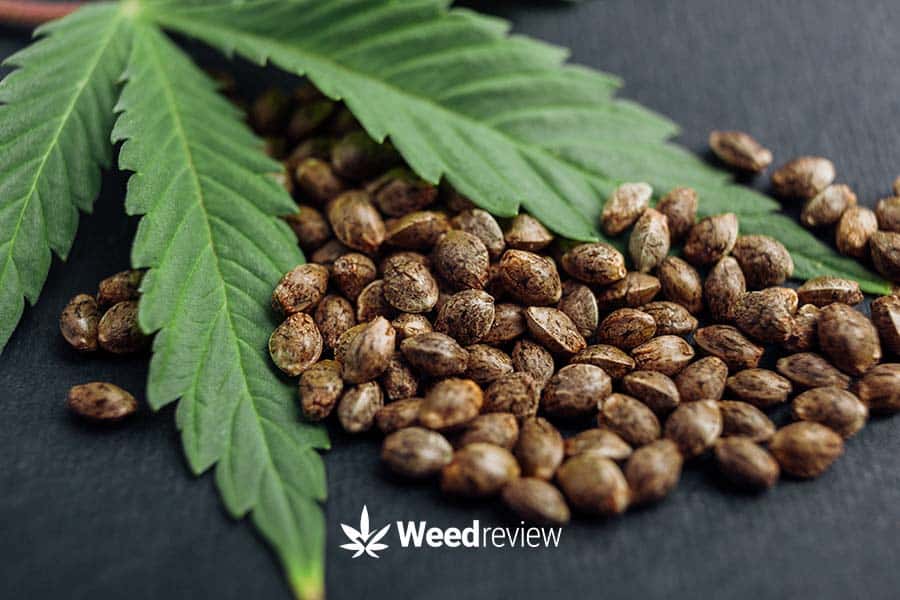
Cannabis Seeds: Basics, Types, Legality, How to Choose

Table of Contents
The journey of marijuana cultivation begins with a tiny powerhouse: the cannabis seed.
Whether you’re a seasoned grower or just starting, understanding cannabis seeds properly is crucial. These wonders hold the genetic key to a variety of strains, medicinal properties, and exciting cultivation experiences.
In this guide, we will explore the basics of marijuana seeds, giving you the knowledge to select the perfect seeds for your needs.
Understanding marijuana seeds: The basics
Cannabis seeds are the reproductive units of the marijuana plant. They are small, oval-shaped structures that contain the genetic material necessary for plant growth and development. Cannabis seeds have a hard outer shell that protects the embryo inside.
The seeds come in different sizes, shapes, and colours, depending on the specific strain and genetics. They sprout and grow into cannabis plants with unique traits and characteristics:
- THC/CBD concentration
- Terpene profile
- Colour and aroma
- Growing time
- Flowering periods
- Length of the plant
- Yield
- Resistance to pests & molds
Legality
Thai citizens can grow cannabis in the country, as per the latest cannabis laws. Therefore, the purchase of seeds is also legal – provided they are bought from licensed, legal retailers operating in the country. Before growing, the citizens must register on the government-approved ‘Plook Ganja’ app.
Note that it is prohibited to transport cannabis seeds or any part of the cannabis plant to and from Thailand for personal use.
Types of cannabis seeds
In the market, you will find a range of cannabis seeds, each catering to different goals and purposes.
Whether you seek commercial ventures, medicinal uses, personal cultivation, or even the pursuit of creating new strains through selective breeding, it’s important to understand the three distinct choices available to you.
Regular seeds
Regular cannabis seeds are natural, unaltered seeds that can develop into both male and female plants.
When regular seeds are germinated and grown, there is an equal chance of the plant being male or female. Male plants produce pollen, while female plants produce resinous flowers (buds) that contain higher levels of THC and other cannabinoids.
Breeders use regular seeds to create new strains or preserve genetic diversity in cannabis varieties.
When regular cannabis plants are cross-pollinated, the resulting seeds contain genetic traits from both the male and female parent plants. The seeds carry a combination of traits inherited from each parent, including characteristics such as growth patterns, aroma, taste, cannabinoid content, and more.
Cannabis breeders have the ability to create new strains or stabilise existing ones by selectively breeding plants with desired traits. They achieve this by carefully selecting regular seeds and determining which plants to cross-pollinate. Breeders can then choose the offspring with the most desirable characteristics and continue breeding them in subsequent generations.
Feminised seeds
Feminized cannabis seeds are selectively bred to produce only female plants.
Through a specialised breeding process, breeders manipulate the genetics of the plant to eliminate the expression of male chromosomes. This ensures that nearly all the resulting plants from feminised seeds will be female.
Female plants are desired by most growers because they produce resinous flowers that are rich in cannabinoids.
Other advantages include:
- Higher yield efficiency by eliminating the need to identify and remove male plants.
- Consistency and predictability in plant characteristics, flowering times, and cannabinoid profiles.
- Easy option for breeders, allowing for focused breeding efforts without the need to manage male plants.
Autoflower seeds
Autoflowering cannabis seeds are a relatively recent innovation in the world of cannabis cultivation.
These seeds are specifically bred to transition automatically from the vegetative stage to the flowering stage without being dependent on specific light cycles.
Traditional cannabis plants require a change in the light cycle to trigger flowering – something like the 12-hour-dark & 12-hour-light cycles.
However, autoflowering seeds contain genetics from Cannabis Ruderalis, a subspecies of cannabis that naturally flowers based on age rather than light exposure. Autoflowering plants have a shorter life cycle and are often smaller in size, making them suitable for growers with limited space or those seeking a faster harvest.
Auto-flower marijuana seeds are popular because:
- Faster harvests due to their shorter life cycle based on age rather than light cycles.
- Simple and low maintenance, making them ideal for novice growers and those with limited space.
- Continuous harvest potential, allowing for multiple harvests within a single growing season.
- Stealthy and discreet growth with compact size and quick flowering time.
- Robust genetics and resistance to common issues like mould and pests.
How to choose cannabis seeds
It can be quite confusing to get the right kind of weed seeds for your requirements. Here is a handy checklist of things to ask yourself before you go to buy cannabis seeds.
What are you looking for
Consider your personal goals and preferences before you step into the market. Do you:
- Need it for recreational use, medicinal benefits, or both?
- Take it for personal use or business use?
- Prefer a particular flavour, aroma, or effect?
- Enjoy high-THC varieties or high-CBD strains?
- Have a shortage of space?
- Grow your plants indoors or outdoors?
- Have experience in growing?
- Want a strain that is easy or difficult to grow?
Considering that there are hundreds of cannabis strains out there, you need to have an idea of what exactly you need so you can narrow down your options. If you are a beginner, consider choosing an autoflowering strain which is resistant to diseases.
Type of cannabis varieties
Cannabis strains are often categorized as Indica, Sativa, or hybrid, each offering distinct characteristics.
- Indica strains tend to provide relaxing and sedating effects.
- Sativa strains are associated with mentally uplifting and energising effects.
- Hybrid strains combine the traits of both Indica and Sativa, offering a mix of effects.
It has to be said that this classification is only a rough estimation of how the effects of the strains will be. That is, a Sativa variety like AK-47 can put you to sleep, while an Indica variant like Northern Lights can give you a strong creative rush. It is more about the chemical profile of the strain, that is, the percentages of CBD, THC, and the types of terpenes it has.
If you have never tried cannabis before, try a few strains, see how you feel, and then invest your efforts into growing something that you enjoy.
Flavour, aroma, terpenes
Flavour and aroma are essential aspects of the cannabis experience, contributing to the overall enjoyment and sensory delights. Terpenes, the aromatic compounds found in cannabis, shape the taste and smell profiles of different strains.
Each strain possesses a unique combination of terpenes, resulting in unique scents and tastes.
From fruity and citrusy to earthy and piney, the diverse mix of terpene profiles offers an exciting range of flavours and scents to explore. For example, Gelato is a popular strain with a fruity, vanilla-like smell, while Sour Diesel is known for its skunky diesel scent.
THC & CBD levels
The levels of THC (tetrahydrocannabinol) and CBD (cannabidiol) in cannabis strains guide their effects and potential therapeutic benefits.
THC is known for its psychoactive properties, while CBD is associated with various medicinal properties and non-intoxicating effects.
Find your desired THC to CBD ratio based on your goals, whether it be for recreational use, symptom relief, or other specific purposes.
Growing conditions & strain traits
Consider your growing conditions and environment when choosing cannabis seeds.
Some strains thrive in specific climates or indoor setups, while others are more adaptable. Factors such as temperature, humidity, available space, and lighting capabilities should be kept in mind. You will also find strains which do well outdoors and require minimal effort.
Similarly, some strains are prone to moulds and pests and are very sensitive to surroundings – making them a challenge to grow. Then there are varieties which are highly resilient to plant diseases, which makes them easy for breeders to cultivate.
Research strain characteristics and choose seeds that are well-suited to your particular growing conditions to maximise the chances of a successful and rewarding cultivation experience.
Indoor v outdoor growing
Indoor cultivation allows for greater control over the growing environment. You can regulate temperature, humidity, light exposure, and air circulation, creating optimal conditions for your plants. However, they have high set-up and maintenance costs and require more attention.
Outdoor cultivation relies on the natural environment, which can result in larger plants and yields due to the abundant sunlight. However, it also subjects the plants to the uncertainties of weather and pests. On the bright side, outdoor grows have lower costs, less equipment, and require little technical knowledge for a good yield.
How to buy seeds: Cannabis seed banks
A cannabis seed bank is essentially a shop that specialises in storing seeds from various cannabis strains. These banks maintain the biodiversity of cannabis plants and offer plenty of strains to choose from.
Seed banks typically provide detailed information on each strain, including growth patterns, THC and CBD content, flavour profiles, and growing requirements.
Choosing seeds from a reputable store ensures high germination rates and accurate strain features as described on the packaging.
Storing seeds
Once you have your cannabis seeds, proper storage is needed to maintain their life for future cultivation. When storing seeds, a few key factors should be kept in mind:
- Temperature: Cannabis seeds should be kept in a cool place, as heat can reduce their germination rate. A refrigerator set at a temperature between 6-8 degrees Celsius (42-46 degrees Fahrenheit) can be an ideal storage environment.
- Humidity: Low humidity levels are key to preventing mold and bacterial growth. Relative humidity should be kept between 20%-30%.
- Light: Seeds should be stored in a dark place as light can stimulate unwanted germination or degrade the seeds.
- Airtight container: Seeds should be stored in an airtight container to control humidity and temperature.
Cultivating cannabis seeds
Cultivating cannabis seeds requires attention to detail, an understanding of plant care, and commitment.
Germination process and methods
Germination is the initial step in the cultivation process. It involves encouraging the seed to sprout and grow into a seedling. Three methods can be used for germination:
Paper towel method
To begin, place the seeds between two damp paper towels, creating a moist environment that encourages germination. Make sure the paper towels remain consistently moist, but avoid excessive wetness, as this can lead to seed rot.
By using this method, you can easily monitor the progress of germination as the seeds develop roots and sprouts. Once the seeds have sprouted, you can carefully transfer them to a growing medium, such as soil or a hydroponic system, for further growth.
Soaking seeds in water
Begin by submerging the seeds in room temperature water for a designated period, typically between 12 to 24 hours. This process softens the seed coat and kickstarts water absorption, triggering the germination process.
After the soaking period, transfer the seeds to a growing medium, ensuring they are placed in a suitable environment where the emerging taproot can continue its growth. Soaking seeds in water can help promote successful germination and give your seeds the best chance of developing into healthy seedlings.
Starter plugs/germination cubes
These pre-made cubes or plugs are specifically designed to create an optimal environment for seed germination. Simply place the cannabis seeds into the designated holes or depressions in the cubes or plugs, following the manufacturer’s instructions.
The starter plugs, or germination cubes, provide excellent moisture retention and aeration. This allows the seeds to sprout and develop roots.
The method ensures consistent conditions for germination and simplifies the transfer of seedlings to a larger growing medium once they have established a strong root system.
Vegetative stage and care
After germination, the seedling enters the vegetative stage, focusing on leaf and stem growth. During this phase, providing optimal conditions is crucial.
This includes providing sufficient light, balanced nutrients, proper watering, and maintaining a suitable temperature and humidity level. Pruning and training techniques can also be employed to shape the plant’s growth and promote better yields.
Flowering stage and light cycle
As the plant matures, it enters the flowering stage, during which it develops buds. To trigger the flowering stage, cannabis plants typically require a change in the light cycle, transitioning to a 12-hour light/12-hour dark period.
Providing the appropriate light spectrum, intensity, and duration is vital to encourage bud formation. Regularly monitor and maintain the plant’s environment, ensuring proper air circulation, temperature, and humidity for optimal growth and resin production.
In the case of autoflowering seeds, the flowering stage begins automatically when the plant reaches a certain age.
Harvesting and curing techniques
Harvesting is the end of the cultivation process, involving careful selection and cutting of mature cannabis buds. This is done while preserving the delicate trichomes that house valuable compounds.
After harvesting, buds must undergo proper drying and curing. Drying involves hanging buds in a well-ventilated area to evaporate moisture, preserving aromas and preventing harsh flavours gradually. Curing follows drying, where you transfer the buds to sealed containers for several weeks to release excess moisture and develop enhanced qualities, such as improved aroma, smoother smoke, and increased potency.
These techniques ensure a high-quality cannabis product that showcases the plant’s full potential in flavour, potency, and preservation.
Conclusion
The selection of high-quality seeds, understanding their characteristics, and choosing the right type for your goals are essential steps towards a rewarding growing experience. Whether you’re cultivating marijuana for recreational, medicinal, or personal use, the careful nurturing and attention given to seeds can produce remarkable results.
Remember, each growing journey is an opportunity for learning and improvement – and a lot will depend on the type of seeds you choose.


